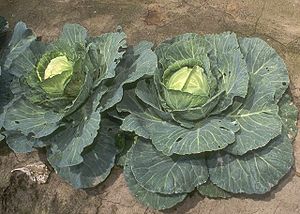Cruciferous vegetables facts for kids
Cruciferous vegetables are vegetables of the family Brassicaceae (also called Cruciferae) with many genera, species, and cultivars being raised for food production such as cauliflower, cabbage, kale, garden cress, bok choy, broccoli, Brussels sprouts, mustard plant and similar green leaf vegetables. The family takes its alternative name (Cruciferae, New Latin for "cross-bearing") from the shape of their flowers, whose four petals resemble a cross.
Ten of the most common cruciferous vegetables eaten by people, known colloquially in North America as cole crops and in the UK, Ireland and Australia as brassicas, are in a single species (Brassica oleracea); they are not distinguished from one another taxonomically, only by horticultural category of cultivar groups. Numerous other genera and species in the family are also edible. Cruciferous vegetables are one of the dominant food crops worldwide. They are high in vitamin C and soluble fiber and contain multiple nutrients and phytochemicals.
List of cruciferous vegetables
Extensive selective breeding has produced a large variety of cultivars, especially within the genus Brassica. One description of genetic factors involved in the breeding of Brassica species is the Triangle of U.
| common name | genus | specific epithet | Cultivar group |
|---|---|---|---|
| Horseradish | Armoracia | rusticana | |
| Land cress | Barbarea | verna | |
| Ethiopian mustard | Brassica | carinata | |
| Kale | Brassica | oleracea | Acephala group |
| Collard greens | Brassica | oleracea | Acephala group |
| Chinese broccoli (gai-lan / jie lan) | Brassica | oleracea | Alboglabra group |
| Cabbage | Brassica | oleracea | Capitata group |
| Savoy cabbage | Brassica | oleracea | Savoy Cabbage group |
| Brussels sprouts | Brassica | oleracea | Gemmifera group |
| Kohlrabi | Brassica | oleracea | Gongylodes group |
| Broccoli | Brassica | oleracea | Italica group |
| Broccolini | Brassica | oleracea | Italica group × Alboglabra group |
| Broccoflower | Brassica | oleracea | Italica group × Botrytis group |
| Broccoli romanesco | Brassica | oleracea | Botrytis group / Italica group |
| Cauliflower | Brassica | oleracea | Botrytis group |
| Wild broccoli | Brassica | oleracea | Oleracea group |
| Bok choy | Brassica | rapa | chinensis |
| Komatsuna | Brassica | rapa | perviridis or komatsuna |
| Mizuna | Brassica | rapa | nipposinica |
| Rapini (broccoli rabe) | Brassica | rapa | parachinensis |
| Choy sum (Flowering cabbage) | Brassica | rapa | parachinensis |
| Chinese cabbage, napa cabbage | Brassica | rapa | pekinensis |
| Turnip root; greens | Brassica | rapa | rapifera |
| Rutabaga (swede) | Brassica | napus | napobrassica |
| Siberian kale | Brassica | napus | pabularia |
| Canola/rapeseed | Brassica | rapa/napus | oleifera |
| Wrapped heart mustard cabbage | Brassica | juncea | rugosa |
| Mustard seeds, brown; greens | Brassica | juncea | |
| White mustard seeds | Brassica (or Sinapis) | hirta | |
| Black mustard seeds | Brassica | nigra | |
| Tatsoi | Brassica | rosularis | |
| Wild arugula | Diplotaxis | tenuifolia | |
| Arugula (rocket) | Eruca | vesicaria | |
| Field pepperweed | Lepidium | campestre | |
| Maca | Lepidium | meyenii | |
| Garden cress | Lepidium | sativum | |
| Watercress | Nasturtium | officinale | |
| Radish | Raphanus | sativus | |
| Daikon | Raphanus | sativus | longipinnatus |
| Wasabi | Wasabia | japonica |
Further relationships inside the family Brassicaceae can be described by tribes, a grouping of genera (see Brassicaceae § Relationships within the family). Armoracia, Barbarea, and Nasturtium belong to the tribe Cardamineae; Brassica, Sinapis, Diplotaxis, Eruca, and Raphanus belong to Brassiceae; Lepidium belongs in Lepidieae; and finally Wasabia (Eutrema) belongs in Eutremeae.
Research
Cancer
Cruciferous vegetables contain glucosinolates, which are under research for their potential to affect cancer. Glucosinolates are hydrolyzed to isothiocyanates (ITCs) by myrosinase. ITCs are being investigated for their chemopreventive and chemotherapeutic effects. An example is the finding that the ITC phenethyl isothiocyanate reduced levels of the oncoprotein MCL1. Other in vitro research indicates ITCs may affect levels of the BCR-ABL fusion protein, the oncoprotein active in leukemia.
Taste
People who can taste phenylthiocarbamide (PTC), which is either bitter or tasteless, are less likely to find cruciferous vegetables palatable due to the resemblance between isothiocyanates and PTC.
Contraindications
Although cruciferous vegetables are generally safe for human consumption, individuals with known allergies or hypersensitivities to a certain Brassica vegetable, or those taking anticoagulant therapy, should be cautious.
See also
 In Spanish: Verduras crucíferas para niños
In Spanish: Verduras crucíferas para niños


